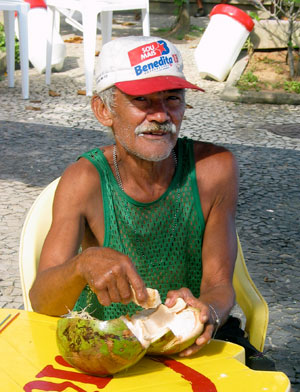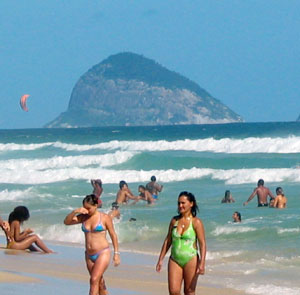RIO DE JANEIRO, BRAZIL - A ray of early morning sunshine kissed my cheeks and aroused my interest about the noise coming from outside.
It was barely 7 a.m. but already hundreds of people were setting up small tents and umbrellas on the world-famous Copacabana Beach across the street from my Copacabana Palace hotel room.
Suddenly, I remembered the warning of my city tour guide, Rodrassis, from a day earlier: "Tomorrow is Sao Sebastino day (St. Sabastien is the patron saint of Rio) and everyone goes to the beaches on holidays. You better get there early if you want a spot close to the water."
I rushed to put on the standard dress in Rio - a bathing suit - and hurried downstairs to cross busy Avenida Atlantica, the multi-lane thoroughfare that snakes alongside most of the 23 pristine white beaches that make this city the surf capital of the world.
I was about to cross the boulevard when I remembered another of Rodrassis' warnings: "There are two types of pedestrians in Rio - slow ones and dead ones. Drivers in Rio believe roads were only made for cars and they will stop for nothing."
I wondered if I should pray to Sao Sebastino before darting across the street. Fortunately, half the four-lane boulevard was closed to traffic because of the holiday.
I kicked off my sandals as soon as I hit the beach - and soon put them back on because, despite the hour, the grains of sugary sand closest to the street felt like hot coals.
The few hundred Cariocas, the name Rio citizens are known by, I saw from my hotel window about an hour earlier had now multiplied into thousands.
There is reportedly a 38 per cent unemployment rate in this country of almost 170 million and all 38 per cent appeared to be on the beach that morning.
Copacabana is the favorite of all the beaches in Rio. It stretches four kilometers along the southern Atlantic coast and is home to 700,000 of the city's 10 million residents. Copacabana is also where most of the city's hotels are located. On New Year's Eve, over two million people gather on Copacabana for what people here call the "best New Year's Eve party in the world.”
There is a Portuguese expression you hear a lot in this city - eu riu (pronounced rio). It means to laugh. And they riu a lot in Rio, especially on the beaches, where young children break into laughter when they throw themselves into the oncoming surf that pounds the beach with such force that it lifts little bodies out of the water and deposits them a half-dozen metres away.


Left: You meet some interesting characters walking along Rio’s beaches. Right: There always a crowd of people on Rio’s beaches.
Great fun, it seems.
While Copacabana may be the favorite beach in this amazingly beautiful city, it's not the most famous. That honor goes to Ipanema, known worldwide by the song The Girl From Ipanema, written about a local woman who made men swoon when she walked along the hot sand. The woman, Helo Pinheiro, now 57, has been the subject of many interviews and recently made headlines again when she posed with her model daughter (25-year-old Ticiane) in a Playboy magazine spread.
Rodrassis also suggested I visit Barra (pronounced baha) Beach because "it is the most beautiful and it is where most of the city's wealthy people live."
The 19 kilometer stretch of Barra Beach is where you will find some of the most expensive property in all of South America. For example, the average cost of real estate on Copacabana Beach is $1,000 (U.S.) per square meter but on Barra, it triples to $3,000 (U.S.) a square meter.
This is the area of the city where most of the country's revered soccer stars live. A day earlier, my guide pointed to a sandy colored building next to Barra Beach and told me that was where super star Ronaldo - he led Brazil to its record fifth World Cup championship in Korea a few years ago and is considered a god here - had converted the top three floors of the building into one apartment.
The beaches along Avenida Atlantica are separated by the many granite mountains that dominate the city's skyline and are linked by a series of tunnels - 45 in all. The longest is the one that connects Berra Beach with Ipanema. It stretches 6.5 kilometers.
There would be plenty of time to explore the other beaches later in the afternoon. For now, I was content lying in the sun at an area of Copacabana Beach roped off for guests of the world-famous Orient Express-owned hotel.
I watched bronzed bodies wiggle out of tight shorts, revealing some magnificent physics (some surgically enhanced, no doubt, since Rio is the plastic surgery capital of the world) clad in the tiniest of bathing costumes. The person who owns the rights to string bikinis and thongs in Rio is no doubt the richest person here.
The average temperature of the southern Atlantic at this point is 23C but, despite the harshness of the early morning sun, the water lapping the shore at Copacabana was still quite frigid to the touch. That did not prevent the locals from running into the water, though. Some younger local women were content to stand on the shore and offered seductive poses for a group of awestruck male British tourists who snapped photo after photo while their mates were kept busy eyeing a group of scantily-clad young men playing sand soccer.
Nudity is expected but not seen on the public beaches here. It is frowned upon by local authorities and Rodrassis told me the younger women of Rio want to dispel their naughty image around the world.
Rodrassis had also told me that Brazilian kids practically "live" on the beach.
"Some kids are even born on the beach. In fact, my mother went into labor with me when she was at a beach and that's why she always called me a son of a beach."
Rodrassis fancied himself as somewhat of a comic.
Soon after you arrive at Copacabana Beach, you are greeted by samba musicians who serenade beachgoers until they throw money their way - usually just to get them to leave. Samba rhythms were not music to my ears, I discovered.
Less annoying are the hawkers who want you to buy everything from sun tan lotion, to sun glasses and hats, to brightly decorated table cloths - all at very negotiable prices - and cans of local beer.
"You want a beer, mister?" a young man in a thong bathing suit asked.
Taking note that it was now almost noon, I said yes. The young man returned a few minutes later with a cold can of local beer and asked for two real - about 60 cents. He even offered to run a tab for me.
The non-alcoholic drink of choice of beachgoers in Rio is something called coco duck, a local coconut whose milk tastes more like sweet water.
The hawkers usually leave the beach around 4 p.m. to set up makeshift stalls along Avenida Atlantica, where tourists can purchase local crafts - some amazing creations for just a few dollars - and leather goods at flea markets that have become as famous here as the beaches. The markets stay open until about 10 p.m.
The beach areas of Rio are lined with lots and lots of restaurants, many offering the traditional meal of barbecued meats called churrascaria that is delivered to your table on huge skewers and carved onto your plate. The all-you-can-eat churrascaria is accompanied by a side buffet of local fish and salads. Servers continue to deliver the meats - mostly beef and sausage - until you beg them to stop. The cost of a top quality churrascaria is around $20.
As Sao Sebastino day drew to a close, even more people began arriving at Copacabana Beach.
"We have big party here tonight," said a local woman. "We party all night to celebrate Sao Sebastino."
There seemed to be as many people as grains of sand on Copacabana Beach.
"Maybe 250,000, maybe more … much more," said a tourist policeman - members of the Brazilian army who patrol most major tourist sites in Rio and are recognized by arm bands with the words 'tourist police' on them - as he surveyed the huge throng and tried to estimate its size. Vendors had joined the crowd, selling local sausages and a taste treat called churros - a long, sweet doughnut filled with vanilla or chocolate cream that costs just $1 - for two. Yummy!
The audience had gathered to hear local artists sing the upbeat tunes of this seductive country. I decided to retreat to my hotel room and enjoy the concert from the comfort of my balcony that overlooked the beach and the makeshift band shell.
The well behaved crowd partied all night and for the first time ever, I enjoyed being kept awake.
The next morning at breakfast, my server observed: "You look a little tired this morning seignior."
"Blame it on Rio," I responded.